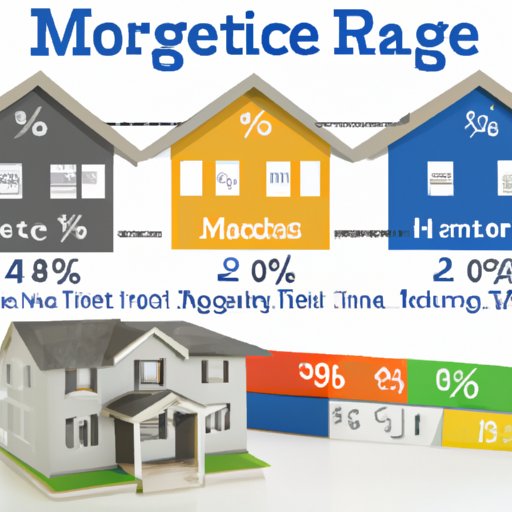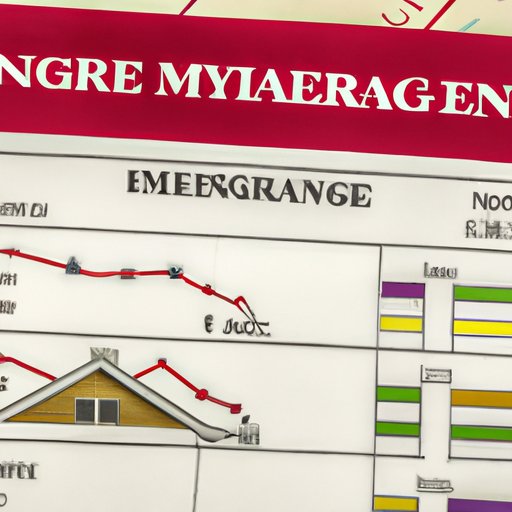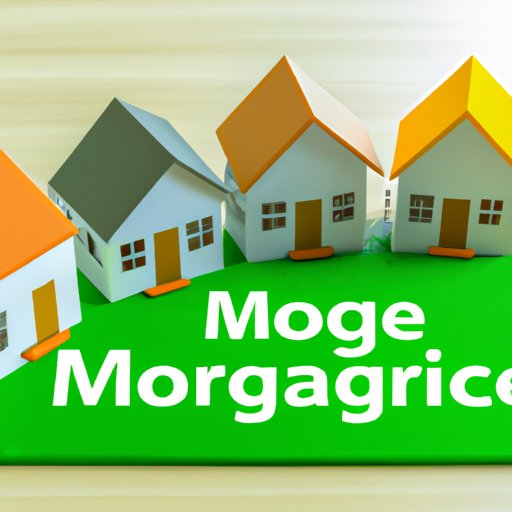Introduction
Mortgage interest is a fee charged by lenders to borrowers in exchange for the use of their money. It’s an important factor to consider when taking out a loan, as it can make a huge difference in the total cost of the loan over time. In this article, we’ll explore how mortgage interest works, how it’s calculated, what types of mortgage interest rates are available, and strategies for reducing mortgage interest payments.
Explaining How Mortgage Interest Accrues Over Time
When you take out a loan, you agree to pay the lender a certain amount of interest over the life of the loan. This interest is added to the principal balance of the loan and compounds over time. As a result, the longer you take to pay off the loan, the more interest you will end up paying.
For example, let’s say you take out a $100,000 loan with a 4% interest rate and a 30-year term. Over the course of the loan, you will pay a total of $143,739. That means the total interest paid over the life of the loan is $43,739 – almost half of the total cost of the loan.
To help visualize how this works, most lenders provide an amortization schedule, which outlines the total amount of interest and principal paid each month. With this information, you can easily see how much of your monthly payment is going toward interest versus principal.

Breaking Down the Different Types of Mortgage Interest Rates
There are three main types of mortgage interest rates: fixed-rate mortgages, adjustable-rate mortgages (ARMs), and hybrid mortgages. Let’s take a closer look at each one.
Fixed-Rate Mortgages
A fixed-rate mortgage is a loan with an interest rate that stays the same throughout the life of the loan. This type of loan is ideal for borrowers who want predictable monthly payments and the security of knowing their interest rate won’t change.
Adjustable-Rate Mortgages
An adjustable-rate mortgage (ARM) has an interest rate that can fluctuate over time. ARMs typically start off with a lower interest rate than fixed-rate mortgages, but they can increase over time if market conditions change. This makes them riskier than fixed-rate mortgages, but they can also be beneficial for borrowers who plan to stay in the home for a short period of time.
Hybrid Mortgages
A hybrid mortgage is a combination of a fixed-rate mortgage and an adjustable-rate mortgage. The loan starts off with a fixed interest rate, but after a certain period of time – typically five or seven years – the rate switches to an adjustable rate. Hybrid mortgages can be beneficial for borrowers who want the security of a fixed-rate mortgage but don’t want to be locked into a long-term loan.
Examining How Points, Origination Fees and Closing Costs Impact Mortgage Interest Rates
In addition to the interest rate, there are several other factors that can impact the cost of a mortgage. Let’s take a closer look at some of the most common.
Points
Points, also known as discount points, are a one-time fee paid to the lender in exchange for a lower interest rate. The amount you pay depends on the lender and the size of the loan, but typically ranges from 0.5% to 2% of the loan amount. For example, if you take out a $200,000 loan and pay 1 point, you would owe the lender an additional $2,000.
Origination Fees
Origination fees are charged by the lender to cover the administrative costs associated with processing the loan. These fees typically range from 0.5% to 1% of the loan amount and are usually non-negotiable.
Closing Costs
Closing costs are fees associated with the closing process, such as title insurance, appraisal fees and attorney’s fees. These costs vary depending on the lender and the location, but typically range from 2% to 5% of the loan amount.
Analyzing the Benefits and Drawbacks of Fixed- Versus Variable-Rate Mortgages
When deciding between a fixed-rate and variable-rate mortgage, it’s important to consider the benefits and drawbacks of each. Let’s take a closer look.
Benefits of Fixed-Rate Mortgages
The primary benefit of a fixed-rate mortgage is the predictability of the payments. You know exactly how much you’ll be paying each month, making budgeting easier. Additionally, fixed-rate mortgages tend to come with lower interest rates than variable-rate mortgages, so you could potentially save money over the life of the loan.
Drawbacks of Fixed-Rate Mortgages
The downside of a fixed-rate mortgage is that you could end up paying more in interest if market rates drop. Additionally, if you plan to move or refinance within the first few years of the loan, the savings from a variable-rate mortgage may outweigh the stability of a fixed-rate mortgage.
Benefits of Variable-Rate Mortgages
The primary benefit of a variable-rate mortgage is the potential for lower interest rates. If market conditions are favorable, you could end up paying significantly less interest than you would with a fixed-rate mortgage.
Drawbacks of Variable-Rate Mortgages
The biggest drawback of a variable-rate mortgage is the uncertainty of the payments. Your payments could increase significantly if market conditions change, making it difficult to budget and plan ahead. Additionally, variable-rate mortgages tend to have higher interest rates than fixed-rate mortgages, so you could end up paying more in interest over the life of the loan.

Investigating Strategies for Reducing Mortgage Interest Payments
If you’re looking to reduce the amount of interest you pay on your mortgage, there are a few strategies you can try. Let’s take a look at some of the most popular.
Refinancing
One of the best ways to reduce your interest payments is to refinance your loan. Refinancing involves taking out a new loan with a lower interest rate and using the proceeds to pay off the existing loan. This can significantly reduce the amount of interest you pay over the life of the loan.
Making Additional Payments
Another strategy for reducing your interest payments is to make additional payments on your loan. By paying more than the minimum each month, you can reduce the total amount of interest you pay over the life of the loan. Just be sure to check with your lender to make sure any additional payments are applied to the principal balance.
Shopping Around for a Lower Interest Rate
Finally, you can save money on your interest payments by shopping around for a lower interest rate. Comparing rates from multiple lenders can help you find the best deal, so don’t be afraid to shop around before committing to a loan.
Conclusion
Mortgage interest is an important factor to consider when taking out a loan. Understanding how it works and the different types of mortgage interest rates available can help you make an informed decision. Additionally, exploring strategies for reducing mortgage interest payments, such as refinancing, making additional payments, and shopping around for a lower interest rate, can help you save money in the long run.
At the end of the day, the key to minimizing your interest payments is to do your research and make sure you understand all of the terms and conditions of your loan. Taking the time to compare rates and shop around for the best deal can go a long way in helping you save money.
(Note: Is this article not meeting your expectations? Do you have knowledge or insights to share? Unlock new opportunities and expand your reach by joining our authors team. Click Registration to join us and share your expertise with our readers.)
